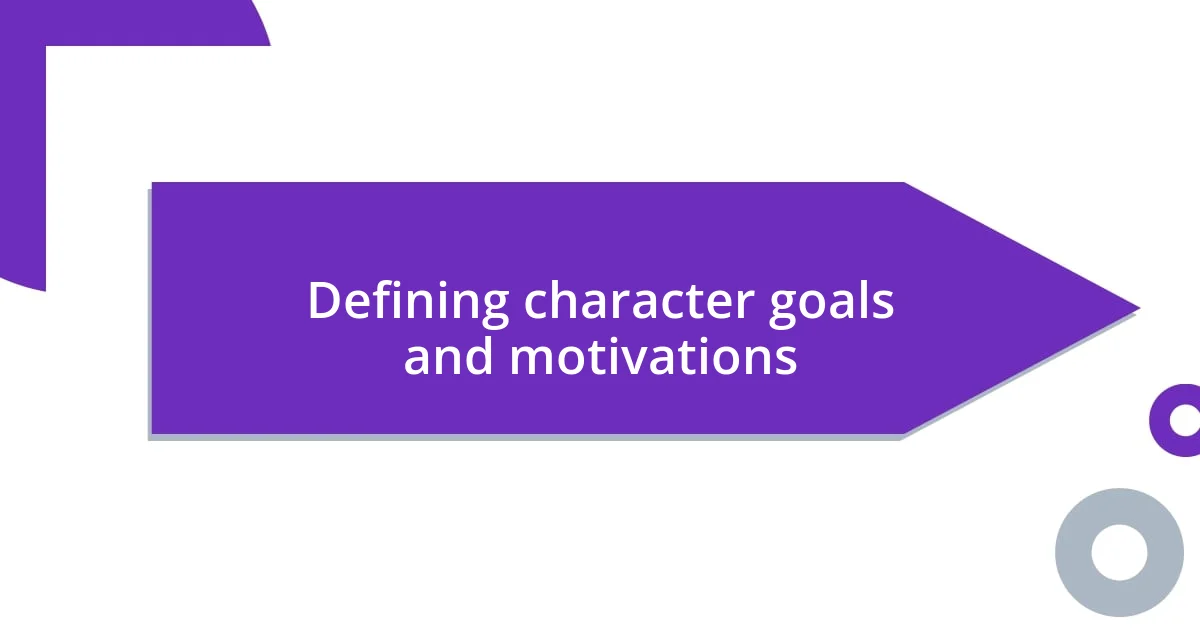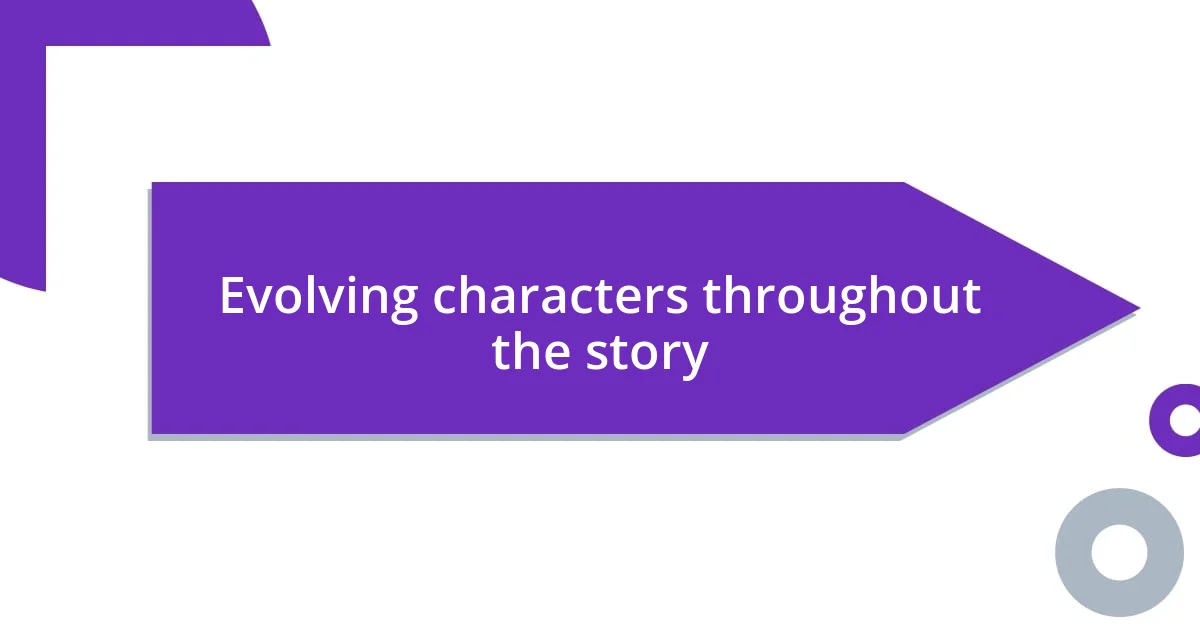Key takeaways:
- Character development involves creating relatable flaws, emotional arcs, and complex backstories that resonate with readers and foster empathy.
- Defining clear goals and motivations for characters, along with incorporating internal conflicts, enhances narrative depth and engages the audience.
- Memorable dialogue and evolving character traits through experiences and relationships help to illustrate growth, making characters more dynamic and relatable.

Understanding character development
Character development is all about creating depth and complexity in your characters, transforming them from mere sketches into vibrant human beings. I remember when I was crafting a character who struggled with self-doubt; I delved into my own experiences of insecurity. This not only resonated with me but allowed readers to connect with the character’s journey more deeply. Have you ever felt your character’s fears echo your own? That emotional resonance is what makes them memorable.
As I’ve learned over time, every character should have a clear arc—a transformation that unfolds throughout the story. I once explored the arc of a seemingly villainous character who, through unexpected circumstances, revealed a heartbreaking past. This shift forced me to reconsider their motivations, demonstrating how layered characters can invite empathy, even from the most unlikely readers. How do your characters evolve in your stories and why might that evolution resonate so strongly with the audience?
Moreover, it’s crucial to give your characters flaws, as perfection doesn’t resonate with real-life experiences. When I wrote a character who was overly ambitious, I intertwined their successes with the collateral damage they caused in their relationships. This intentional imperfection not only made the character relatable but also sparked discussions among readers about ambition and its costs. Have you considered how your characters’ flaws can create deeper connections with your audience? Understanding this aspect of character development is essential in crafting enduring, relatable figures in your narratives.

Defining character goals and motivations
Defining a character’s goals and motivations can significantly shape their journey and how readers perceive them. When I created a character who yearned for acceptance, I drew inspiration from my own experiences of wanting to belong during my school years. This personal reflection helped me craft a character whose pursuit felt genuine, driving their decisions and actions throughout the story. I always ask myself, what does my character truly want, and why? This exploration helps ensure that their journey resonates with readers.
I’ve also found that contrasting a character’s external goals with their internal motivations can create a layered narrative. For example, I once designed a character who sought success in their career but was secretly grappling with the need for parental approval. This duality added tension to their decisions; every time they prioritized work over relationships, I reminded myself of the sacrifices I’ve witnessed in those around me. Such complexity fosters empathy in readers, inviting them to reflect on their struggles.
Creating memorable characters involves articulating their goals clearly while embedding a deeper motivation underlying those objectives. During my writing process, I often visualize my characters sitting across from me, sharing their dreams and fears. In doing so, I build a relatable persona that readers can root for—or even against. Have you tried tapping into your character’s deeper motivations? It’s a rewarding way to make them truly unforgettable.
| Character Goal | Internal Motivation |
|---|---|
| Acceptance | Need for Belonging |
| Success | Parental Approval |
| Adventure | Escape from Routine |

Crafting unique character traits
Crafting unique character traits requires intentionality and a dash of authenticity. I’ve found that integrating quirks or distinctive habits can make characters stand out. For instance, I once created a character who always doodled during serious conversations. This tiny trait not only added humor but also revealed their struggle with anxiety. It allowed readers to see a different side of them, making this character more relatable and memorable.
To bring your characters to life, consider these strategies:
- Unique Vocabulary: Give your character a distinct way of speaking. Maybe they mix in slang or use overly formal language at unexpected times.
- Physical Traits: A unique hairstyle or an unusual fashion sense can make a character visually distinctive. Think of the boy with vibrant blue hair or the woman with a penchant for vintage hats.
- Fascinating Hobbies: Introduce hobbies that show depth. Perhaps your character is an amateur birdwatcher or a secret competitive yo-yo master.
- Contradictory Traits: Balance rigidness with spontaneity, like a serious accountant who secretly loves to break into spontaneous dance.
- Emotional Responses: Craft characters that react uniquely to situations. I wrote one who laughed inappropriately during tense moments, illustrating their discomfort and making readers question their sanity.
Through conscious and thoughtful crafting of these traits, I believe you can create characters that linger in the minds of readers long after closing the book.

Utilizing conflict in character arcs
Utilizing conflict in character arcs is essential for creating depth and intrigue. I remember writing a character who faced the challenge of betrayal from a trusted friend. This conflict served as the catalyst for a transformation that pushed them to confront their own flaws and insecurities. Isn’t it fascinating how conflict can be a powerful teacher? Through my character’s journey, readers not only witnessed their struggle but also empathized with their growth.
The magic of conflict often lies in its ability to reveal hidden truths about our characters. For example, I created a protagonist who was overly confident in their abilities until a series of failures forced them to confront their fears of inadequacy. As I penned their journey, I reflected on my own challenges with self-doubt; it made writing this arc both painful and cathartic. How often do we mask our vulnerabilities? In allowing my character to face this conflict, I enabled readers to explore their own experiences, forging a stronger connection.
Moreover, conflict shouldn’t be limited to external battles. I’ve experienced firsthand how internal conflicts can make characters extraordinarily relatable. I crafted a villain who was not simply evil but who struggled with their past mistakes. This complexity made them more human in my eyes; I had to grapple with the reality that sometimes, the darkest characters are fighting their own battles. Have you considered what internal struggles your characters might face? The beauty of storytelling lies in revealing those layers, showing readers that every conflict holds the power to change us.

Creating relatable backstories
Creating relatable backstories is like giving your characters a soul; it provides a foundation for their actions and motivations. I always find myself delving deep into a character’s past to unearth their fears, dreams, and regrets. For instance, I once crafted a character who grew up in a single-parent household, which sparked in them a fierce sense of independence. This touchpoint made their journey resonate with readers who understood the complexities of balancing strength with vulnerability.
When I think about bringing life to a character’s backstory, I often consider how pivotal moments shape who we become. Remember that time you faced a challenging decision? For a character I’m developing, a choice between pursuing their passion or helping their family shaped their sense of identity. By mirroring real-life dilemmas, I find it easier for readers to relate to my character’s struggles and triumphs. Isn’t it fascinating how a relatable conflict can bridge the gap between fiction and reality?
As I weave backstories, I connect emotional experiences to traits or quirks. I’ve created a character with a habit of collecting vintage postcards, which ties back to the loneliness of moving around as a child. Each postcard represents a longing for roots, a desire for connection. I believe that these layered backstories not only enrich character development but also evoke empathy from readers, making them root for the character’s journey. How do your characters’ past experiences shape their present? The answers lie in the stories you choose to tell.

Employing memorable dialogue techniques
Memorable dialogue is a powerful tool in character development, as it allows readers to truly hear the voices of the characters. I once wrote a scene where a character, feeling vulnerable, used humor as a defense mechanism. The witty banter not only highlighted their fear but also invited readers to laugh alongside them, providing a deeper understanding of their personality. Have you ever noticed how a quick, sharp exchange can reveal so much about a character’s emotional state?
Another technique I find effective is using unique speech patterns or phrases that resonate with the character’s background. For instance, I wrote a character who frequently employed metaphors drawn from their love of gardening. Every time they spoke, I aimed to create vivid imagery that reflected their nurturing nature and desire for growth. Isn’t it interesting how a simple phrase can transport readers into a character’s viewpoint and make their dialogue unforgettable?
Finally, I’m a firm believer in letting characters interrupt one another or speak over each other to mirror real-life conversations. This chaotic element not only enhances the authenticity of their interactions but also conveys tension or excitement. I recall writing a heated argument where the characters were so passionate that their words tangled, echoing the chaos of real-life disputes. How often do you find yourself lost in a conversation where emotions run high? This approach adds layers to their relationships, making each dialogue exchange a dynamic reflection of their complex lives.

Evolving characters throughout the story
Evolving characters are essential for keeping readers invested in the story. I once crafted a character who began as a timid wallflower but transformed into a fierce leader by the end of the narrative. Observing how small challenges—like standing up to a bully or making a new friend—gradually pushed her out of her comfort zone was a joy to write. Don’t you find it exciting to watch a character rise to the occasion, revealing strength you didn’t initially see?
As I develop my characters, I often think about how their experiences change their perspectives. Take, for instance, a character who starts with naïve optimism, only to face betrayal that leaves them jaded. This shift not only showcases their growth but also sets the stage for complex relationships moving forward. How does losing trust shape a character’s actions, and how might it resonate with readers who’ve faced similar heartbreaks?
In one of my stories, a character’s evolving relationship with a mentor completely changed their outlook on life. Initially, they viewed this mentor as infallible, but as secrets surfaced, their admiration turned into a struggle between respect and disappointment. It’s a powerful reminder that growth doesn’t come from simply overcoming obstacles; it’s also about navigating intricate emotions. Have your characters faced moments that shifted their views entirely? These changes can create a rich tapestry of emotional depth that resonates long after the story ends.














